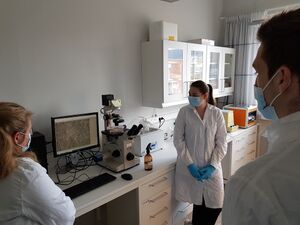Microfluid incubator
Contents
Microfluid monitoring incubator
Description
Here's a presentation of the concept
Introduction
The rage of the 2020s are organs-on-a-chip [1]. These are systems that have to be specifically engineered for each type of organ. Growing and maintaining cell cultures, however is a more generic activity of cell biology. They are kept in expensive incubators and several times a week they have to be looked after and the growth media replaced. When there are too many cells, most of them are killed and some are re-applied in a new flask/petri dish. All this can be done inside a lab on a chip[4]. In addition, the incubator functions of controlling temperature, CO2 and O2 pressure can be reduced to small modules in a standalone cell culture system that is small enough to be moved from lab to lab and between research microscopes at different imaging facilities. Adding electrodes to the system will allow electrochemical or bioimpedance monitoring of the cell coverage, a feature that will be publishable in a scientific journal.
The system is perhaps not the most exciting project to start with, but it contains all the basic technology needed for more advanced organ-on-a-chip systems: temperature, gas and fluid control, hydrogel membranes, monitoring of cell state, etc. It will be a platform that LagLivLab students can build on and modify for years.
References
[1] B. Zhang, A. Korolj, B.F.L. Lai, M. Radisic, Advances in organ-on-a-chip engineering, Nat. Rev. Mater. 3 (2018) 257–278. doi:10.1038/s41578-018-0034-7. [4] F. Bunge, S. van den Driesche, M.J. Vellekoop, Microfluidic platform for the long-term on-chip cultivation of mammalian cells for Lab-on-a-Chip applications, Sensors (Switzerland). 17 (2017) 1–15. doi:10.3390/s17071603.
Work in progress
Checkplot of prints, whole print, Anniken's circuit updated, viewed from polyester side (when doing phototlitho, text should read correctly seen from top when placing transparency on wafer).
Notes
To test the gradient generator we use methylene blue that has a diffusion coefficient of (6.74 ± 1.32) × 10−10 m2/s (https://doi.org/10.1134/S0030400X19060213). The gradient generator worked well, but it has to be repeated at controlled flow rates to find max flow rate
Cell adhesion
Cells did not adhere directly on the glass bottom surface. Next, we tried filling the channels with collagen, but only a few cells adhered. According to doi:10.3390/bios10110182 collagen is found to be the best surface treatment for adhering cells in microfluidic circuits. We should therefore check the protocol and try again. According to doi:10.1016/j.colsurfb.2016.11.011 (3-Aminopropyl)triethoxysilane (APTES) can be used as a linker of collagen to PDMS, maybe it works for glass as well?
